Designing Tapestry-My Way-Kathe Todd-Hooker
I think, the two questions that I am asked more often then any question(s) other then “How long does it take to weave a tapestry? and “Where do your designs come from?” My stock answer to the time question. “It takes what it takes. it just is!”
The answer to How do I design and create my images is a tad bit more complex, but after years of teaching and doing, This is my answer short abbreviated answer to the design question.
There’s nothing magical to it. The design just happens, but in a structured, organized easy to follow way. Life evolves in strange ways. Turns out AND, I would never have guessed in the beginning that I could be this
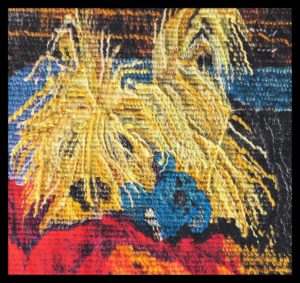
Kyra- tuckered out!
methodical and organized. BUT, in the end this is just a process like warping that I endure so that I can get to the weaving and creating the final image from a black and white cartoon.
BEGINNINGS-
Step one: Write a Focus Statement.
Focus statements are composed of about 3 sentences. They are extremely concise-a statement of purpose that changes or may change as you work to the end of the design process. It’s a beginning, a starting point, a focusing point. This is also where I list timing and deadlines for a piece.
Step two: Beginning the process. What do you know about the tapestry?
Write 20 things you do know about the future tapestry. If I can’t come up with 20 things then I need to probably do more research. With the exception of what
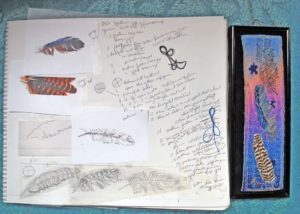
20 questions and piece-
I call studies-colour studies(my scenic pieces-sunrises, fog sunsets etc. and pix of Kyra and Chene or sample tapestries for specific reasons) Studies are usually 10 to 12 things that I know about a piece.
Examples: size needed,
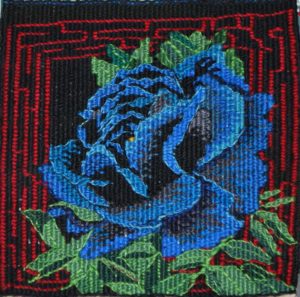
Another study I would expect to get no more then 10 things on the list!.
materials, subject matter, materials, anything I know that I want in the final design.
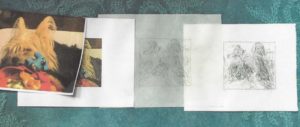
More usual for studies and only 10 things written about in the studies-Photo, sized tracing/drawing, vellum cartoon.
Write 10 things you know about each of the images you have decided to use. Examples: soft or hard edges? What colours? Meaning of image or symbol? Mood of the piece? I am a pictorial weaver. I research my images and symbols. (Don’t take symbols or images for granted. They have multiple meanings to different people and different cultures. Know your audience. Do your research)
Start a dialogue and personality with your new piece. Treat it as a separate entity-not as an extension of your thinking process, but with it’s own identity and reasons to exist. Ask it what it wants to do-needs to do become a separate entity and stand on it’s own. Literally create a dialogue. Write it out like a screen play if necessary.
Collect the images you think you will use- drawings, paintings,photos, images,
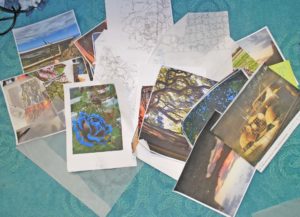
My library of things-pix, drawings, templates ideas I am using in my next piece-Sunrise or sunset?
photocopies of images.
At this point size is not an issue. I actually have over the years created my own library of “things” that I might want to use in the future-photographs, my drawings, words/ fonts, patterns, pictures of painting-to remind me of directions I might want to think about, scraps of things, mazes, puzzle pieces. Copy those images try not to work from an original for the next step. Cover with tracing paper.
Step three: Develop the Cartoon
Make a fast layout sketch on paper. (A schematic – A road map for where you’re going to put stuff later on or perhaps not, but what you think it could possibly be -drawing from your original 20 questions of what you do know about the piece.) At this point don’t worry about size.
Step Four: Tracing images
Tracings Draw, photocopy, photograph, etc. Use the medium you’re comfortable with to get the images you will want to use. Make several black/white copies of these
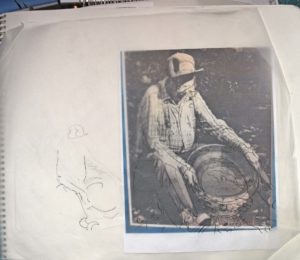
Tracing photos, you can see where the first tracing was to small so I blew up the image to a more weavable size.. You can also see if you look closely I have started the tracing lines and they are purposely moved a bit. AND, Yes, that’s Stein panning for gold.
images. Do an outline tracing of each image as you wish to use. Leave out any details you don’t need or want to use as you trace.
Cut the tracings out close to the tracing lines.
Trace outlines of the black/white images with pencil and darken in with ink when you’re sure of the line.
Step Five: Beginning layout
Lay tracing paper images on top of the schematic drawing and arrange images to suit. Remember you can flip the images; turn them upside down, etc. Photo Shop or Gimp (free program) are great programs if you have them. One of my favourite tools is my scanner. I scan images into my computer and insert into word and use the size tool to make things the proper size. You may find that you need to reduce the size of one of the images to go with the rest of your chosen images. You can photocopy it or scan it into your computer to do so. If you have overlapping images, decide which ones are going to be on top. Size can be changed by scanning images and reducing the size up or down at any time.
Step 6: Final layout
Get a comfortably sized piece of paper to layout the tracings.
Some people prefer to do this on cheap paper-not much of an investment if you choose to wad it up and start over. Try not to make it so precious that it’s difficult to discard if you don’t like the initial design. (A piece of paper that feels comfortable
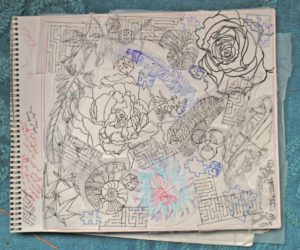
Layout of overlapping pieces in final position.
for you to work with. The size of the design can be adjusted later to be the actual size of the piece.) Draw out the proportions you need (as written about in the statement above.-example 10 by 12 inches or feet or anything in between) Add an inch around the finished design size. (You’ll need this later for mounting the cartoon.) Decide if you are weaving from the front or the back. If working from the back, all the designs from this point on must be
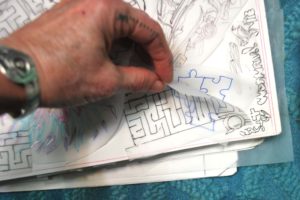
layering traced images.
reversed.
Tape the paper to the work surface with blue tape. using clear tape the images together when they are arranged to your liking. If you need to change the size of the piece, trace the design onto tracing paper and enlarge or reduce it with a copy machine.
Step 7: The vellum cartoon
If you aren’t changing the size of the piece, lay a piece of vellum directly over the taped together design, tape it down to the table (with blue tape) and trace the design
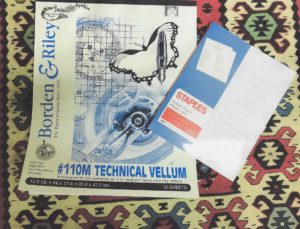
Large vellum tablet for anything over 8.5 inches x 11 inches. Favourite vellum for small cartoons Staples inkjet/laser white vellum # 26232.
onto the vellum with a pencil. If you have changed the size of the design, tape the
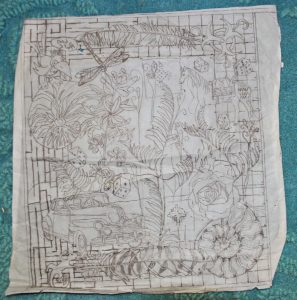
A well used cartoon
vellum over the new image.
Now take a pencil and trace the design through the vellum. Where tracings overlap you can now choose which one should be in the forefront and which will disappear under the shapes you are tracing.
if you have the luxury of time, you may want to mount the cartoon on
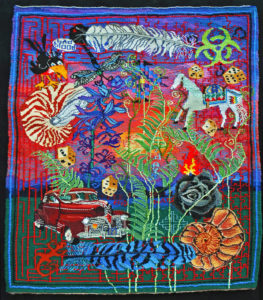
Second coming once again. Actual tapestry that goes with this cartoon.
the wall and live with it a bit. If you do choose to live with it make any changes before the next step.
Step 8: The final step
Go back over the pencil marks on the vellum with a laundry marker. If the design is very complex, use a colored pen or pencil to lightly color in the shapes to help you differentiate between the different shapes within the weaving.
Step 9: Preparing to Weave
On the cartoon draw two heavy vertical lines that will correspond with two marked warps on the warp. Draw two horizontal lines and measure to make sure they stay horizontal during the weaving process. This can be at the top of the weaving for small format pieces or every foot on a large format tapestry.

All used up, beaten up ripped by needles- normal usage for a cartoon. Sometimes good things fall apart so better things can happen!
Weave a heading or selvedge. In small format pieces this may be a selvedge that you remove after the piece is woven.
Sew the vellum to the tapestry heading and your ready to weave. This is where the extra space around the edges comes into play. It gives you space to sew the cartoon to the selvedge and the extra on the edges helps to place or move the cartoon into place. I use round needles to make the sewing easier. When I sew or baste the cartoon I leave the long stitches on the back and short stitches on the front.
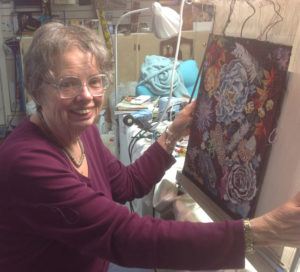
This is probably a silly question. How do you know where to draw your vertical lines so that they will correspond to a warp thread? Isn’t it just as likely that they will fall between warps?
Between the warp is close enuff! Align the cartoon first and then pick the warp that is closest. Being between is close enuff-So pick the closest warp and always relate the cartoon line to that warp.
Cheers, kathe
PS I don’t thing any question is silly. I thing it wouold be silly not to. It made me think that I could have been a little more specific or word it slightly different. Thanks, kathe
Thank you so much Kathe for sharing your design process in such detail. I love the idea of a focus statement.
This is a process that I started doing years ago and it really works for me. I really like the focusing statement because it gives me starting place. Without it I can waste more time trying to think of where to begin. once I get the focusing statement everything seems to fall into place.